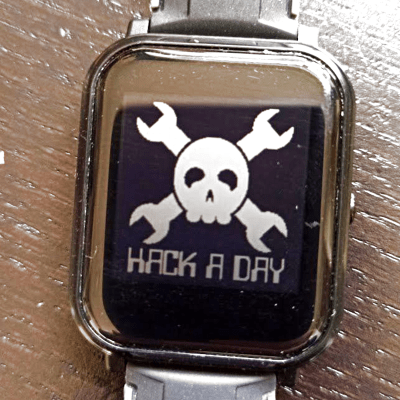The open source world and Chinese manufacturing have a long relationship. Some fifteen years ago, the big topic was how companies could open-source their hardware designs and not get driven bankrupt by competition from overseas. Companies like Sparkfun, Adafruit, Arduino, Maple Labs, Pololu, and many more demonstrated that this wasn’t impossible after all.
Maybe ten years ago, Chinese firms started picking up interesting hacker projects and producing them. This gave us hits like the AVR transistor tester and the NanoVNA. In the last few years, we’ve seen open-source hardware and software projects that have deliberately targeted Chinese manufacturers, and won. We do the design and coding, they do the manufacturing, sales, and distribution.
 But this is something else: the Bangle.js watch takes an essentially mediocre Chinese smartwatch and reflashes the firmware, and sells them as open-source smartwatches to the general public. These pre-hacked watches are being sold on Kickstarter, and although the works stands on the shoulders of previous hacker’s reverse engineering work on the non-open watch hardware, it’s being sold by the prime mover behind the Espruino JavaScript-on-embedded language, which it runs on.
But this is something else: the Bangle.js watch takes an essentially mediocre Chinese smartwatch and reflashes the firmware, and sells them as open-source smartwatches to the general public. These pre-hacked watches are being sold on Kickstarter, and although the works stands on the shoulders of previous hacker’s reverse engineering work on the non-open watch hardware, it’s being sold by the prime mover behind the Espruino JavaScript-on-embedded language, which it runs on.
We have a cheap commodity smartwatch, being sold with frankly mediocre firmware, taken over by hackers, re-flashed, re-branded, and sold by the hackers on Kickstarter. As a result of it being (forcibly) opened, there’s a decently sized app store of contributed open-source applications that’ll run on the platform, making it significantly more useful and hacker friendly than it was before.
Will this boost sales? Will China notice the hackers’ work? Will this, and similar projects, end up in yet another new hacker/China relationship? We’re watching.
















Years ago, after the war, all major cities had a ‘surplus’ row. There you could buy all manner of radios and parts that were left over from the war effort. We also had the Heath kits and later the Ramsey and Rainbow kits. As the war surplus slowed down, these shops migrated to electronic surplus – left overs from making all manner of consumer good. As surface mount cam along, there was also the shift to offshore building, Japan, Taiwan, Hong Kong all took up this task. US surplus dried up, with the exception of military production which stayed in the USA for strategic reasons. The military surplus(MIL) was less in quantity as well. Surface mount MIL was usually coated with a conformal coating = hard to remove, as parts were cheap we could buy.
With the Chinese and Taiwanese and Hong Kong and Japan being production centers, they had their surplus areas. In many Chinese cities, these tend to be in certain areas, like Akihabara in Japan.
In all these places you could find buildings full of small shops selling all manner of new and surplus good. Often specialized = switch shops, wire shops, IC shops, SM parts and so on. – row on row, stall on stall. The experimenter can take his list and buy almost all his parts. He can buy ovens, soldering irons, pliers, dykes, and so on.
There is nothing like that in the USA now – there are isolated shops with a broad selection of all of this, but not a deep selection as you find in Asia.
Take a look at Shenzhen tours on YouTube and die of envy. I hope to take a trip to Shenzhen after the Covid is over, I suggest you think of it as well.
There are a dozens of Chinese online shops, like Ali-express, but they have a 3-6 week mail delay. A few aliespress sellers have US depots for their stuff = faster. Sadly the USPS had politics meddling, and for years funds were diverted from pensions = the Post Office is technically bankrupt as first class mail was killed by e-mail and the politics blocked laying off workers = huge losses. The USPS is trying to add services to pick up this slack.
The root problem can only be fixed by an equalization of USA and Chinese wages, which will shift soe fabrication back to the USA by freight elimination on local stuff.
I’ve been many time to shenzhen and the last one a couple of years ago. The first time was somewhere in 2011 and then i felt like i was in the kids in the candystore.nowadays it is all phone repair stuff and the remaining is sold online.. nothing like the old days. Simular is happening to akihabara and simular areas over the world.
We’rre getting old.
Yes, I was in these places in the 80’s, never yet to Schenzhen, one day…..
I was in Shenzhen in the early 90s, when it was just being built. Dirt roads and sky-scrapers.
For a while, you needed official papers to get into the city — an effort to keep it from booming too quickly. But of course, there were drivers who would smuggle you in, and you could hope to make your fortune.
Real wild-west.
Now it’s just electronics business.
Who’s old now! :)
Yeah I was going to say the same. Used to be able to get stuff a lot cheaper with USD; now the use of dollars is strictly banned. Used to find fakes of stuff that ranged from comical to bang on; don’t really see that any more (unless you are willing to follow a guy to a secondary shady location). Used to have electronic components all over the place; now it is all toy drones and cell phone repair.
Well, it might please you to know that offline electronics markets are still a thing here in Vietnam. Admittedly a bit grimier than what I saw in Shanghai, but I love it.
Good to hear you’re doing well.
Any future articles you might submit?
In my hometown, 25 years ago we had a “Dump store” (Army/Navy Surplus store, this is a general name in the Netherlands – is it elsewhere?) which had general usefull stuff – it was also where you buy good workboots (not just army boots), brooms and some hardware.
Today, there are still Dump Stores, but they tend to cater to preppers and right-wing people with about everything a normal hardware/camping/warehouse would have, just priced three times as much because it has camo print, and usually not the best quality.
Yes, the true military surplus ran out by then, long time since local war supported by massive over production.
The “Powers That Be” probably will never “Equalize” wages. (No profit in doing that)
Here in Los Angles, we actually have several “Old School” surplus outlets.
I took my grandson around for a day, and the “Transfer Of Knowledge” impacted him quite a bit.
Now hes in Finland configuring navigation software for cruise ships.
Yes, they can carry on as long as they owned the place, renters were eventually drive out by the economics/
In the 90s I switched from Army Guard to Air Guard and took almost all my army stuff to surplus store and sold it. Then I went to Air Guard, got out, and once again, sold it all. Then I went back in for the home stretch, got to 20 yrs, retired and once again sold most of stuff.
I used to go to the Electronics Flea Market for ham radio stuff in the 80s, it was pretty action packed. Went about 10 yrs ago with my daugher and it was still cool, but not as exciting as the 80s. A friend and myself were planning on going again, then covid hit and it was cancelled…twice. Now they have lost their parking lot at Frys electronics since they went out of business (that place was happening in the 90s) so they are trying to find a new spot.
The “TRW” ham radio swap was cancelled twice, but now is open for business.
It’s just South of Frys old store.
https://w6trw.com/w6trw-amateur-radio-club-swap-meet/
See you there, last Saturday of every month.
This article feels like it has a subtle anti-chinese slant to it.
I see what you did there.
B^)
“Will this boost sales? Will China notice the hackers’ work? Will this, and similar projects, end up in yet another new hacker/China relationship? We’re watching.”
Tune in next week for another exciting article of, as the opinions fly.
“We do the design and coding, they do the manufacturing, sales, and distribution.”
Closest open-source will come to duplicating it’s software success. Add in the people who analyze down to the transistor level and one can be sure the design sent out, is the design received, and any improvements are noted.
“We do the design and coding” They roll in the money.
The problem I have with most smart watches and wrist monitors is the awful plastic strap. Can’t wear them without getting a sweaty wrist and then a rash within 24 hours. I was lucky to find one with normal strap pins, so I changed it for a real leather strap and it made the watch instantly look about $100 more expensive as well.
I bought a smart watch a Menard`s for a out $5. It lasted about a month.
One of these days I will take a heat gun to remove the back.
Yes, the plasticizer in a cheap plastic band leaches out and irritates the skin, as the plasticizer is lost the band embrittles and breaks = solution a slightly more expensive plasticizer. I do the same, us a continuous leather or synthetic strap, so even if one pin breaks(common) the other pin retains the watch.
Plasticizer leaching can be bad news. Phthalates have been commonly used in the past and are linked to lots of pretty bad things, such as endocrine disruption:
https://en.wikipedia.org/wiki/Phthalate#Health_effects
Yes, ‘butch tits’ come to mind as one of the endocrine side effects…
The long time salvage store left Phoenix recently. It had provided all manner of these things for 50 years I knew of. All generations of tech. Yes the supply of surplus materials, tools, and tech will be the initial challenge
With a sunlight readable always-on screen, 4 week battery life, complete flexibility, and complete control of your data, Bangle.js 2 is a refreshing break from expensive smart watches.
“…sunlight readable, always-on screen, 4 week battery life…” I do not believe this. Does anyone else believe it? If yes, explain how is it done? Later on it says “200mAh battery, 4 week standby time”. That’s a completely different thing! (Misleading.)
If it had an eInk display and only updated once per minute between deep-sleeps, yeah I might believe “sunlight readable, always-on screen, 4 week battery life”.
Plus: One Bangle.js pledge £59 or more, about US$ 81. Estimated delivery Nov 2021. Waaay too expensive IMO. Remember, they’re buying and shipping these jellybean watches by the thousands from China.
Example: This US $27.97 + US $1.15 shipping to US = US $29.12 smartwatch says it has GPS, BT 5.0, touch, IP67 Waterproof, G-sensor, Heart Rate Sensor, 1.75″ TFT 320*385 pixels, 200mAh battery w/~3-7 days standby, and it includes a USB cable:
https://www.banggood.com/bluetooth-Call-Bakeey-MD18-1_75-HD-Large-Screen-BT5_0-GPS-Motion-Track-Heart-Rate-Monitor-Sports-Smart-Watch-p-1819083.html
Buy and drop-ship those cheap smartwatch in 1,000s, and they will get a LOT cheaper! So what justifies the US $81.00 sell price? They say the firmware is open source. It should take very little time and labor to flash the new firmware using a dirt cheap bed-of-nails jig. Better-yet have the new firmware pre-ship flashed in China (wink).
the watch has same display as amazfit bip which is known to last about 40 days because of it too
when I was a kid my dad took me to “Tent City” to purchase a pup tent. Miss that.